Interview by Celia Wickham // Aug. 23, 2019
Marie Ségolène is a French-Canadian artist whose work spans a multitude of creative disciplines, from performance and writing, to installation and bookmaking. Ségolène creates and enacts fantastical realms of desire as a means of exploring narratives of sexuality, trauma and grief. In her expositions of self, she wildly exhibits and carves out pieces of herself to give to the viewer, exploring the fine line of what we offer up to be taken, and what is kept and held sacred for ourselves. There is a violence, a delicacy and a seduction, which leaks out of every piece.
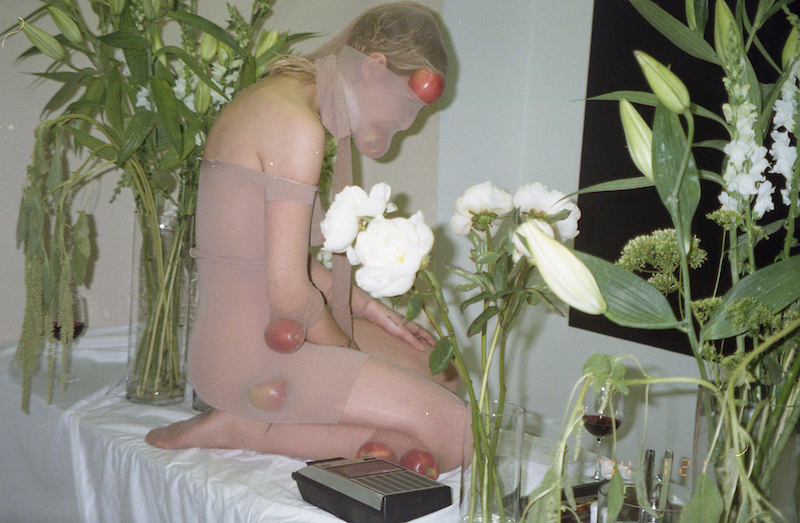
Marie Ségolène: ‘La Fievre (Fever),’ 2018 // Photo by Giselle Gatsby, courtesy of the artist
Through poetic readings that are intertwined with her body-based pieces, Ségolène envisions new and queerer futures that draw from histories of the past, allowing a cathartic excavation to take place. However, this sense of catharsis is oftentimes complicated within the work, as she breaks apart old wounds and opens them up for public inspection, asking the question: what can be healed and how can we hold what remains?
As her work moves more into a sphere of collective healing of trauma and grief, as well as a consideration of radical hospitality and creative dining experiences, we speak about the ways in which we negotiate the peripheries of desire, within ourselves and amongst one another. Ségolène’s work asks: how can we approach trauma and art-making from a place of generosity and care, leaning into the erotic as a site of discovery and recovery?
Celia Wickham: In regards to your explorations of sexuality, desire and the body, what has led you to making performance-based works?
Marie Ségolène: I see my work as very interdisciplinary. The performance aspect is just one part of the research and not necessarily the final product of my work. I think about bookmaking and archiving a lot, but I think that the action of making performances is what leads me to that. My first performances dealt with grief a lot, but now it’s become so much more about desire and the peripheries of desire. Negotiating the spaces of desire between people, and the power dynamics that take place. Now I’m really getting into the idea of radical care and sharing, and that’s what has led me to my new series of work, where I create meals for groups of people. Exploring the dinner table as a site of performative action, as a way of developing my ideas of how we negotiate desire.
It is fascinating to me that my work repeatedly gets approached through the lens of sexuality – in part surely because of the nudity, the language I use, but also certain objects that I often bring into my installations (a gimp mask, a whip, a knife). Those objects are so de-sexualized in my mind at this point. At first, my work was really interested in building structures that restricted my body (thinking of mark-making, thinking of traces and fluids, etc.). When I put the gimp mask on now, I am thinking very sensorially about the smell of leather, about the difficulty breathing, about the sounds that it makes, the rhythm of the voice.
Just when I think I can remove those details from my work, I realise that I am constantly exploring systems of social interactions, power play and desire. The gimp mask is a clear aesthetic marker of submission, in BDSM culture but it is also a historical reference. I have been thinking of gendered labour recently, in relationship to care, and I guess that is just another entry point into the same thing.
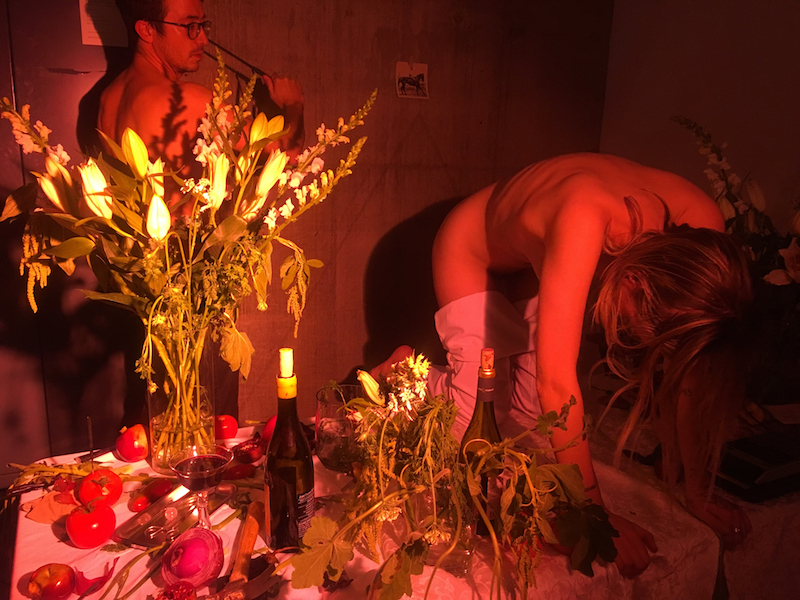
Marie Ségolène: ‘Cruel Song,’ 2018 // Photo by Giselle Gatsby, courtesy of the artist
CW: As you explore desire in your practice, how does this also tie into ideas and themes of trauma?
MS: Over the past two years I’ve been sinking so much into notions of trauma, and the ways in which it comes to define desire. Thinking about the repetition of patterns, or being stuck in a pattern. How those wounds heal or don’t heal. So every metaphor and every idea I was thinking about was always a gap, an opening. A wound that’s reopened, a surgical procedure, a cavity in the body; and then something growing from those places. Now I want to think differently, so that’s why I’m shifting into dinner performances, exploring places where there isn’t so much of a wound.
CW: Can you also talk about uses of the erotic in your work?
MS: There has always been an implicit or explicit use of the erotic in my work, in my writing, performance and drawings. What used to interest me most was ambiguous relationships, specifically power dynamics. Negotiations. The erotic as a clumsy and, at times, highly aesthetic process of negotiation. What is seduction? I am really drawn to intersections of abjection and arousal. When I think of the erotics at this particular stage of my research, it is entirely connected to eating – to the labour of care, to abundance, but also to the idea of the temporary utopia.
Yesterday I visited the Wild Arc Farm to photograph and observe the bottling process. When my friend Leah and I walked up to the farm, a thick, red-violet stream was leaking through the pebbles under my feet. They were cleaning the wooden barrels with steam, the pungent scent of wine. Kombucha, grapes, and apple pulp drying in the sun nearby enveloped us completely. The red hues of the wine were reflecting the light in the stainless steel receptacle as the bottles were being filled, sometimes overflowing. We stood in the sun, voyeuristically observing the humbling precise choreography of sweaty bodies: placing, lifting, corking.
I have been thinking a lot about the mineralities of sweat, and how we might ingest, in our daily life, traces of each other.
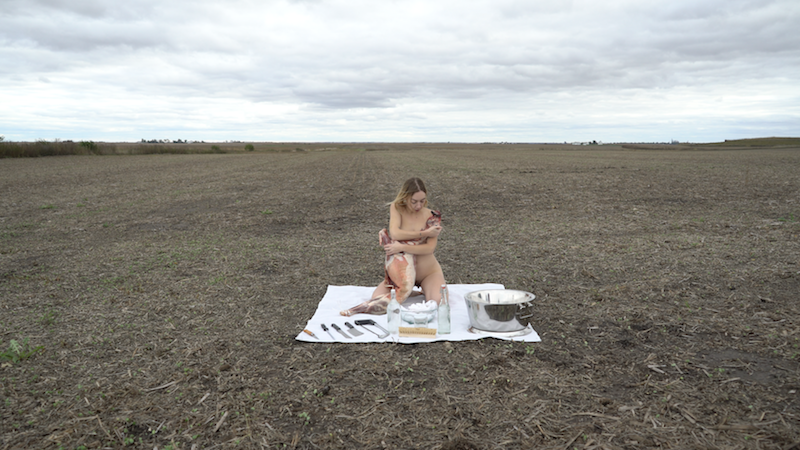
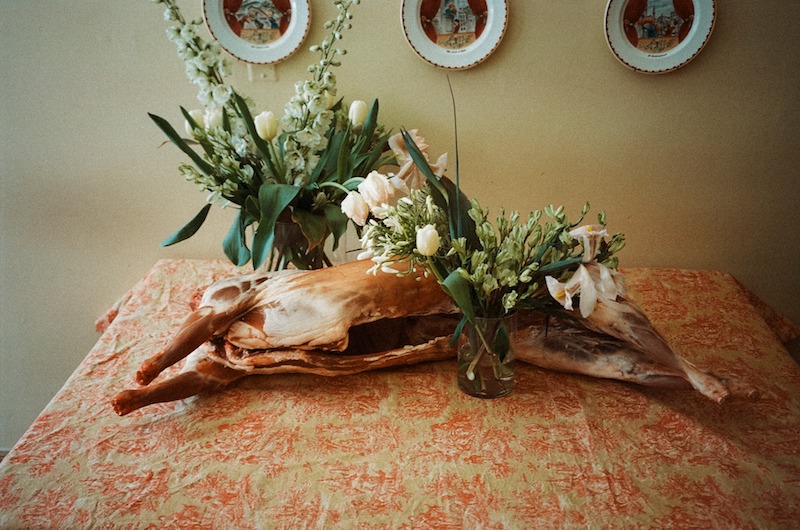
Marie Ségolène: ‘Eye of the Rib,’ 2018, video still // Shot by Devyn Manibo, Courtesy of the artist
CW: In past pieces there is a sense of you exhibiting your grief and trauma as a form of catharsis. How has this process been for you?
MS: I think I’ve spent a lot of time thinking about the spectacle of suffering. My practice is a process of creating frameworks through which I can tap into wounds, open them up and examine them. Although this implies a process of transformation and healing, at some point it became clear that it was not a sustainable creative methodology. I kept having to reopen the wound to make the work, repeat the pattern in order to address the pattern.
In the last few months, this has been something I have been trying to address directly in my work. In ‘Fever’, where I was doing a reading on a table as Apple Boy (a character in stockings with apples inside). I say: “Have we not taught each other how to build out of building, or do we understand building only in relationship to ruination? […] for an instant we may say “How many hands were needed to raise our devotion? But should the question be, how many acts of wounding were needed to finally be receptive to your affections?”
CW: In a sense this work provides a place for healing, but there is also a voyeuristic witnessing or exposing taking place, which complicates things?
MS: There is a true fetishization of suffering in the arts. There is an urgency to address trauma in relationship to gender, sexuality, identity etc., through which it is really difficult to know how to preserve oneself.
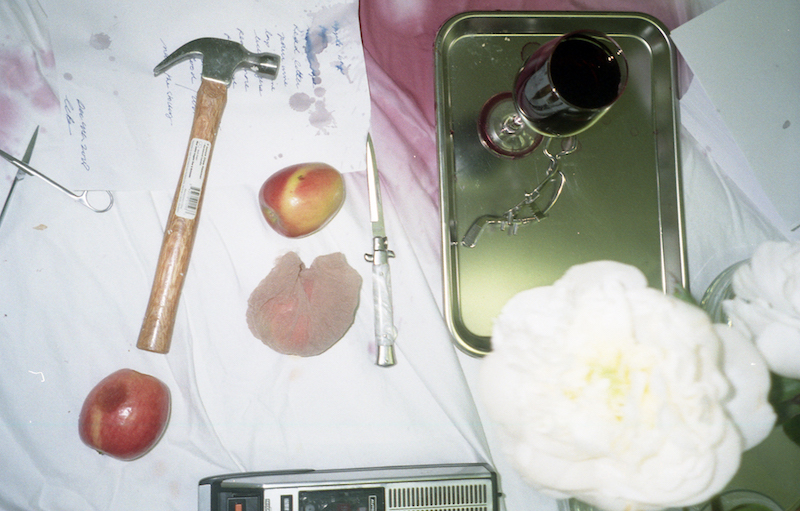
Marie Ségolène and John Londono: ‘Lamb still life,’ 2019// Courtesy of the artist
CW: Is it about approaching these themes from a different angle?
MS: Yeah. I think creating work around a dinner table, you can address those same ideas and questions; trauma still exists, but it can be held collectively. There’s a difference in addressing those themes around a dinner table than on a stage. I like to do poetic interventions when I create the dinner experiences, but there is also collaboration with other artists, where we read texts together and share our writing with each other. There’s generosity and care that’s exhibited, and in the small audiences that are invited to participate, it’s felt, and people are able to take a part in it.
CW: It seems like now you are putting more of a focus on this sense of collective healing, and how we can take care of each other?
MS: For a while I was so interested in catharsis through theatre, and the idea that we can get some form of release from experiencing a really heightened expression of suffering. I feel like people go to see art for that all the time. In my performance work some people could connect with what I was doing, but to other people it completely alienated them and it didn’t resonate at all. Trying to explain to them that what I was doing wasn’t just a narcissistic expression of my experiences. It’s like I am creating the parameters to safely explore these themes. In some ways I feel less creative in doing these dinner table pieces. There’s less urgency in my process, less of a violence, but it also feels healthier. I’m going to be doing more of these pieces over the next few months with lots of different groups of people, so I’m trying to be receptive to what that work brings.
CW: How does queer desire, and the queer body relate to your practice?
MS: The poetics in my work are often entirely sapphic. I like to think of the characters I embody in my work as shifting, at times extremely gendered, at times more androgynous. The narratives of desire in my work follow those of my life in a confessional way. I am currently working on assembling an homage to Sappho’s fragments, which was the script to a performance entitled ‘Agape.’ Close to 100 sapphic love fragments, that explore the sense of abandon into another, in relationship to the loss of self into divine love. I am so inspired by Hildegard Von Bingen. Some of her poetry is so incredibly erotic and I love to imagine the queering possibilities of those texts.
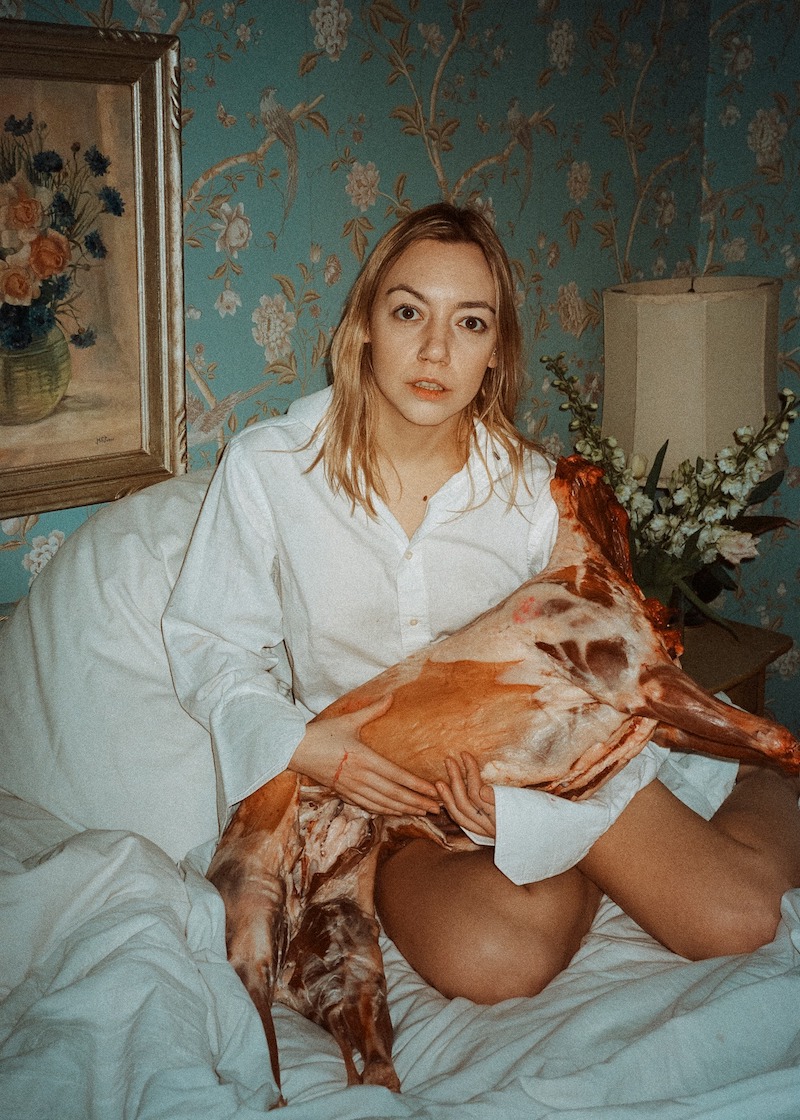
Marie Ségolène: ‘Dinner,’ 2019 // Courtesy of the artist
CW: How does your newer work build upon these narratives of trauma and collective desire?
MS: Well, in the dinner pieces there are still wounds, there’s still cutting into flesh, because there is sharing of meat. All of the symbolics that I use are there still. Part of the dinner table that I find interesting is that you’re exchanging stories with one another, and you’re interrupted by mastication, or swallowing, or pausing and sharing a dish around the table. There’s constant interruptions and fragmentation of stories, and sometimes the intensity crescendos. But there is always a binding element that is the meal, which brings you back to the present. It feels very poetic to me, and is something I always find myself writing about.
CW: Your writing practice is so central to your work. Could you talk about how this process works for you?
MS: I think a lot about fantasy. Sometimes it starts with a fantasy, or the writing creates the place for the fantasy to exist. I also like to think about writing as these fragments and anecdotes that get tied together, these little details that lead into something more.
For example, in the writing I did for the ‘Fever’ piece, I’m exploring this personal story of inheriting an ear infection, that happened with my mother, my grandmother and myself when I was a child. I was thinking about the ear as a cavity and an opening where things can enter. Thinking about the fever of desire as taking place through the ear, and what it would mean if we were to desire only through our ears. It’s very surrealist, and a lot about the repetition of stories and histories. For me, there would be no text without the image that accompanies it.
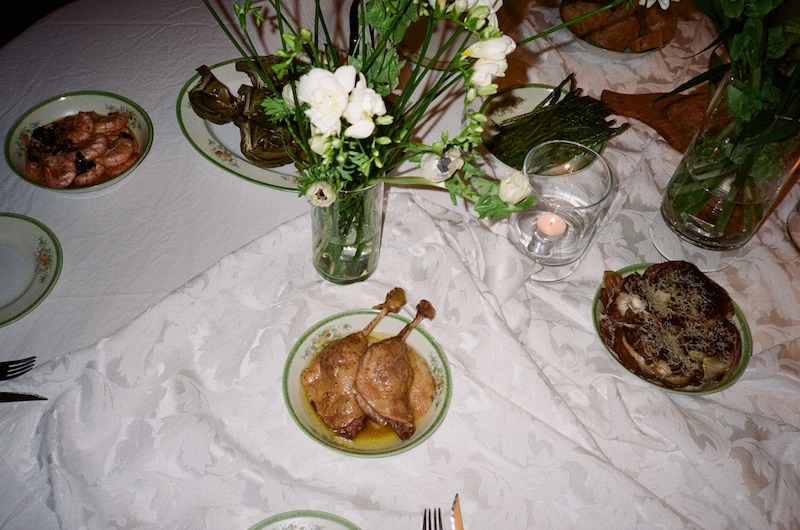
Marie Ségolène and John Londono: ‘Lamb still life,’ 2019// Courtesy of the artist
This article is part of our monthly topic of ‘Sex.’ To read more from this topic, click here.

























